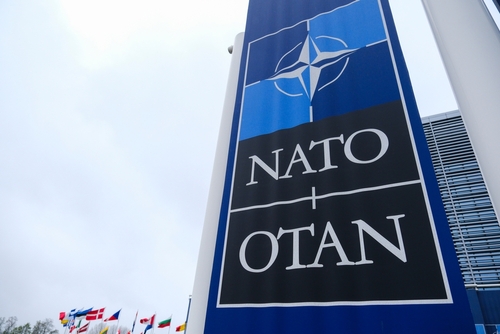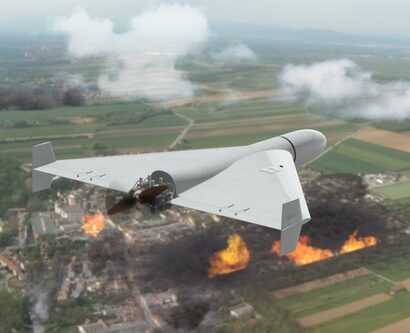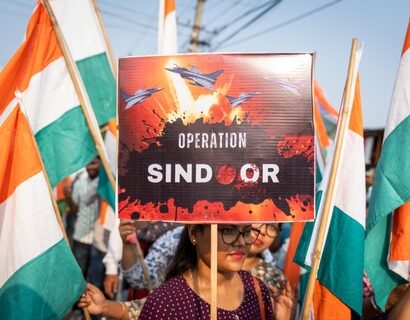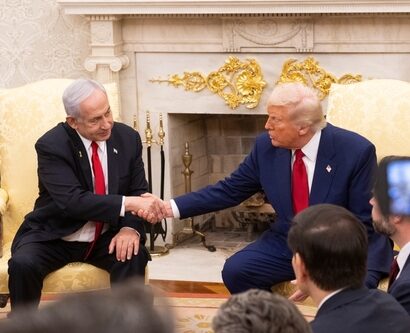Abstract: NATO’s Science and Technology Trends 2025–2045 report represents a significant effort to forecast innovation in the defence-industrial complex. Indeed, upon closer examination, it becomes evident that the report is based on a limited epistemological standpoint and does not fully utilise the possibilities offered by a set of foresight methodologies. There are five key constraints: technocratic framing, lack of ethical engagement, technological determinism, lack of attention to disruptive paradigms and methodological opacity. There is a need for a conceptualisation of strategic foresight grounded in pluralistic, ethical and systems-level understandings.
Problem statement: How can NATO improve its foresight framework to better support ethical and resilient long-term planning?
So what?: To enhance NATO’s strategic readiness, future iterations of this report should adopt pluralistic worldviews, move beyond superficial ethical considerations, and employ transparent and resilient foresight techniques. NATO, its member states and allied foresight communities should redesign collective anticipatory systems using inclusive, systems-based and norm-aware approaches.

Source: shutterstock.com/Alexandros Michailidis
A Critique of NATO’s Foresight
Strategic foresight is critical for military alliances and global governance frameworks to anticipate disruptions and initiate proactive responses. NATO’s Science and Technology Trends 2025–2045 report forecasts technological shifts over the next two decades. While the scope of this effort is commendable, its presentation and methodological execution lack the inclusivity, ethical depth, and transparency required for robust strategic foresight.
Technocratic and Western-Centric Framing
NATO’s Science and Technology Trends 2025–2045 report, as a product of a Euro-Atlantic alliance defined by the Washington Treaty (1949),[1] primarily focuses on technological competition with adversaries, noting that “critical technology areas will shape the future of geopolitical competition”, but marginalises contributions of the Global South. The report largely reflects a linear and capability-driven view of technological progress, whose trajectory is shaped predominantly by emerging tools rather than socio-political contexts.
Critical technology areas will shape the future of geopolitical competition.
However, while NATO’s operational focus under the Washington Treaty remains on its 32 Allies in the Euro-Atlantic region, the Science and Technology Trends 2025–2045 report addresses global technological competition, including threats from non-Allied actors, such as the People’s Republic of China (PRC). The report’s framing of AI and quantum innovation as a primarily U.S.-PRC binary marginalises emerging innovation ecosystems in the Global South—such as India’s $1.2 billion quantum mission, Brazil’s Fiocruz-led biotechnology, and South Africa’s renewable energy through SANEDI. Incorporating Global South perspectives in foresight exercises—via multilateral platforms like the UN or G20—could enhance NATO’s awareness of hybrid threats and technological diffusion, without expanding its mandate or formal partnerships. They would complement its strategic foresight objectives while remaining within established frameworks. Such partnerships would not only enable NATO to leverage India’s quantum expertise to mitigate emerging threats, including quantum-enabled cyberattacks, but also foster a more inclusive and globally connected innovation ecosystem.[2]
Insufficient Ethical and Societal Engagement
NATO’s overarching documents, including the 2022 Strategic Concept, already underscore ethical considerations such as informed consent and societal impacts. Building on this foundation, the Science and Technology Trends 2025–2045 report could further strengthen its analysis by more clearly integrating these principles into discussions of emerging technologies like synthetic biology. While the report acknowledges “risks of harmful uses,” it omits deeper engagement with issues such as informed consent and global inequities—topics increasingly relevant as developments in biodata and biosensors raise complex research security and governance questions. Introducing elements of responsible innovation, such as value-sensitive design (which seeks to align technologies with societal values), would reinforce the report’s coherence with NATO’s existing ethical commitments. Crucially, such an enhancement would operate within the Alliance’s current governance structures and would not require additional consensus-building across its 32 Allies and more than 30 partners, thereby avoiding the practical challenges of broader international negotiations.
Technological Determinism and Contextual Blindness
A key limitation of the Science and Technology Trends 2025–2045 report is its deterministic view of technological change, portraying innovation as an external force shaping geopolitical affairs rather than a process co-evolving with cultural, political, and institutional ecosystems.[3] NATO’s primary mission as a military alliance naturally foregrounds defence-related applications of emerging technologies, including Artificial Intelligence (AI). However, the effective military deployment of AI-enabled systems increasingly intersects with broader ethical and regulatory concerns. For example, public trust in autonomous systems and interoperability with civilian legal frameworks—such as the EU’s General Data Protection Regulation (GDPR)—can directly impact operational legitimacy, interoperability, and cross-border deployments involving NATO Allies. While the Science and Technology Trends 2025–2045 report highlights AI’s transformative potential, it could more explicitly address these interface issues, thereby strengthening the report’s relevance to both military efficiency and Alliance-wide cohesion. Such a framing would remain entirely consistent with NATO’s existing strategic documents and would not require any expansion of its mandate or normative alignment with external actors.
A key limitation of the Science and Technology Trends 2025–2045 report is its deterministic view of technological change.
Building on the report’s focus on strategic competition, it is anticipated that AI and quantum computing will transform industries over the next 20 years, with rivalry among leading global powers likely to intensify.[4] Similarly, the report’s analysis of quantum computing highlights its potential to “shape geopolitical competition”, yet overlooks institutional barriers, such as the need for specialised training, and cultural concerns about ethical implications. Additionally, its treatment of synthetic biology prioritises defence benefits, noting “revolutionary impacts”, while neglecting long-term societal impacts, such as global inequities in access to biotechnologies.
Furthermore, while NATO’s Allies and partners broadly share aligned values, there are notable cultural nuances in trust-building across the Alliance—for instance, relatively high institutional trust in Nordic countries like Finland and Norway, compared to more varied patterns in Mediterranean Allies such as France and Italy. The report’s focus on AI-driven disinformation as a cause of “fragmenting public trust” could benefit from recognising these internal differences to tailor resilience strategies better. Extending this awareness to global actors, considering how countries like India or the People’s Republic of China construct institutional legitimacy differently, could further enrich scenario planning. These reflections would strengthen NATO’s strategic understanding of disinformation dynamics without implying any expansion of its mandate or engagement framework.
Trust in science, institutions, and governments is increasingly undermined by technology.[5] This framing restricts the report’s ability to identify opportunities for social innovation and cross-cultural collaboration, thereby weakening the robustness of its foresight scenarios.[6]
Neglecting Disruptive and Nonlinear Futures
The report acknowledges potential disruptions but fails to explore truly paradigm-shifting scenarios. Black swan events or cascading crises, such as the emergence of artificial superintelligence or post-anthropocentric techno-sovereign futures, are not adequately considered. The reliance on linear trend extrapolation underestimates the significance of discontinuities. Advancements in science and technology will provide solutions to complex challenges, but these solutions will be unevenly distributed across nations.[7]
Black swan events or cascading crises, such as the emergence of artificial superintelligence or post-anthropocentric techno-sovereign futures, are not adequately considered.
Contemporary foresight practices increasingly incorporate complexity science and transformative scenario planning,[8] as Ramirez and Wilkinson suggested, to address such contingencies, which the report could adopt to enhance its resilience.[9]
Lack of Methodological Transparency
The Science and Technology Trends 2025–2045 report’s methodological transparency could be improved by providing more detailed disclosures to strengthen the credibility of its findings.[10]
Although it employs “analysis of open-source materials” and “expert surveys”, it lacks specifics on the design of these methods, such as the number of experts surveyed, their selection criteria, or the role of AI in thematic analysis. For example, AI and biotechnology forecasts do not clarify whether iterative techniques such as the Delphi method or systematic horizon scanning are used, leaving the rigour of predictions unclear. The foresight process in the Science and Technology Trends 2025–2045 report could have been strengthened through the incorporation of advanced techniques such as the Delphi method (to facilitate iterative expert consensus and reduce bias, as demonstrated in Popper’s 2008 guide), backcasting (to map pathways backward from desired strategic outcomes, ensuring alignment with NATO’s resilience goals), and cross-impact analysis (to assess interdependencies among emerging trends and highlight systemic risks). These approaches would have enhanced the robustness and transparency of scenario generation by enabling earlier identification of weak signals, testing the resilience of assumptions, and clarifying alternative futures under uncertainty—ultimately leading to more actionable and adaptive recommendations for Allies. While the report provides a comprehensive trend-based analysis, its current framework may reflect practical constraints, such as time limitations or resource availability in a multi-stakeholder environment, which prioritised efficiency over more participatory or computational methodologies.[11]
While the report provides a comprehensive trend-based analysis, its current framework may reflect practical constraints.
A New Foresight Paradigm
To overcome these constraints, NATO’s strategic foresight activities should be restructured to include the following:
- Plural Epistemologies: Incorporating diverse knowledge systems, such as indigenous, feminist, and postcolonial perspectives, to broaden threat assessments. For example, indigenous knowledge could inform sustainable technology solutions;[12]
- Ethical Integration: Responsible innovation principles, such as value-sensitive design, are embedded in trend analyses to prioritise societal well-being;[13]
- Nonlinear Modelling: This method uses complexity-based techniques to identify weak signals, tipping points, and systemic risks to prepare for disruptive scenarios;[14]
- Methodological Transparency: Clearly documenting foresight processes, assumptions, and stakeholder involvement to foster accountability and trust.[15]
Conclusion
NATO’s Science and Technology Trends 2025–2045 report offers a valuable yet incomplete framework for anticipating future defence and security challenges. Its technocratic perspective, Western-centric focus and linear assumptions limit its effectiveness in a multipolar, ethically diverse world. To foster resilient and inclusive futures, NATO should reframe strategic foresight as a platform for dialogue, imagination, and ethical responsibility. Advances in S&T widen resource gaps while driving growth through AI, bio/green tech, and advanced materials.[16]
Practical steps include establishing interdisciplinary ethics panels, adopting open-source foresight tools such as the Futures Platform, and engaging stakeholders from the Global South in scenario planning.[17] Additionally, insights from RAND Corporation (2023) on emerging defence technologies can guide NATO in aligning its foresight with current trends, ensuring a more robust and inclusive approach.
Insights from RAND Corporation on emerging defence technologies can guide NATO in aligning its foresight with current trends, ensuring a more robust and inclusive approach.
To strengthen the conceptual and strategic integrity of NATO’s long-term S&T outlook, the following recommendations are proposed:
- Integrating ethical foresight into technology governance: Establish cross-disciplinary ethics panels across NATO centres to assess the societal, legal, and humanitarian impacts of emerging technologies during their design and deployment phases.
- Adopting a pluralistic epistemological framework: Engage academic, civil society, and defence experts from the Global South to incorporate diverse perspectives on threat analysis and technological opportunity mapping.
- Enhancing scenario diversity using nonlinear foresight tools: Utilise horizon scanning, Delphi, and participatory future methods to explore unpredictable and disruptive developments that extend beyond traditional military paradigms.
- Institutionalising strategic narrative reviews: Periodically review how future scenarios are framed to avoid techno-deterministic biases and integrate human security and societal resilience dimensions.
- Establishing a future NATO observatory: Establish a dedicated observatory to monitor emerging trends within a value-sensitive, anticipatory framework, integrating data analytics with human-centric forecasting.
Each of these measures not only addresses existing limitations in the NATO 2045 S&T vision but also aligns with the alliance’s democratic values and long-term operational effectiveness.
Sayed Hadi Sadeghi, Ph.D., is an Associate Professor of Cyber Cognitive Intelligence and Learning at Iran’s National Defence University and Head of the Humanities and AI Department at SAMT(The Organisation for Researching and Composing University textbooks in the Humanities). He is an internationally published author who has published with Routledge and Springer. His research interests include cyberspace strategic management, cognitive science, artificial intelligence, e-learning, and their applications in defence and education. Dr. Sadeghi has written extensively in academic journals and books on topics such as AI integration in educational environments, cognitive warfare, and cyberspace strategy. The opinions expressed in this article are the author’s own and do not reflect the views of SAMT or the National Defence University.
Acknowledgement:
This article was developed with the assistance of GPT-4o (OpenAI) for initial text structuring and language refinement, under the author’s full direction, critical analysis, and editorial oversight.
The author thanks Saeed Kayyal, a Ph.D. student in Cyber Studies at the National Defence University in Tehran, Iran, for his valuable contributions to the manuscript. Saeed provided key insights on the cyber aspects of the NATO report, assisted in the literature review focusing on technological determinism and methodological transparency, and contributed to revising the manuscript, reviewing ideas, and offering unbiased suggestions to enhance the article.
[1] NATO, “The North Atlantic Treaty,” April 04, 1949, Washington, DC, https://www.nato.int/cps/en/natohq/official_texts_17120.htm.
[2] Ajeyo Singh, “Quantum Computing in India: A Strategic Perspective,” Journal of Asian Security Studies 15, no. 3 (2021): 45–62.
[3] Andrew Feenberg, Questioning Technology (London: Routledge, 1999).
[4] NATO Science and Technology Organisation, Science and Technology Trends 2025–2045: Exploring the Future of S&T (Brussels: NATO STO, 2023), Executive Summary, https://sto-trends.com/executive-summary.
[5] NATO Science and Technology Organisation, Science and Technology Trends 2025–2045: Exploring the Future of S&T. Brussels: NATO STO, 2023, https://sto-trends.com/executive-summary.
[6] Andrew Feenberg, Questioning Technology. London: Routledge, 1999, 76–80.
[7] NATO Science and Technology Organisation, Science and Technology Trends 2025–2045: Exploring the Future of S&T (Brussels: NATO STO, 2023), Executive Summary, https://sto-trends.com/executive-summary.
[8] Ajeyo Singh, “Quantum Computing in India: A Strategic Perspective,” Journal of Asian Security Studies 15, no. 3 (2021): 45–62.
[9] Nassim Nicholas Taleb, The Black Swan: The Impact of the Highly Improbable (New York: Random House, 2007).
[10] Rafael Popper, “Foresight Methodology: A Practical Guide,” (Brussels: European Commission, 2008).
[11] Ziauddin Sardar, “The Namesake: Futures; Futures Studies; Futurology; Futuristic; Foresight—What’s in a Name?” Foresight 12, no. 3 (2010): 10–17.
[12] Ziauddin Sardar, “The Namesake: Futures; Futures Studies; Futurology; Futuristic; Foresight—What’s in a Name?,” Foresight 12, no. 3 (2010): 10–17.
[13] NATO Science and Technology Organisation, Science and Technology Trends 2025–2045: Exploring the Future of S&T (Brussels: NATO STO, 2023), 33.
[14] Rafael Ramirez and Angela Wilkinson, Strategic Reframing: The Oxford Scenario Planning Approach (Oxford: Oxford University Press, 2022).
[15] European Commission, Foresight for Resilience: Lessons from EU Horizon Scanning (Brussels: European Commission Publications, 2023).
[16] NATO Science and Technology Organisation, Science and Technology Trends 2025–2045: Exploring the Future of S&T (Brussels: NATO STO, 2023), Executive Summary, https://sto-trends.com/executive-summary.
[17] Ajeyo Singh, “Quantum Computing in India: A Strategic Perspective,” Journal of Asian Security Studies 15, no. 3 (2021): 45–62; Ziauddin Sardar, “The Namesake: Futures; Futures Studies; Futurology; Futuristic; Foresight—What’s in a Name?,” Foresight 12, no. 3 (2010): 10–17.




